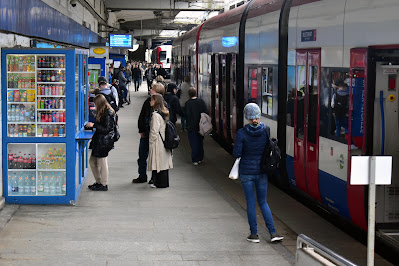In the immediate aftermath of the March timetable change, travelling into town was catastrophic. Worst case? Made it to W-wa Aleje Jerozolimskie in good time to catch an evening train to Chynów - announcement over the speakers: "It's cancelled." An hour's wait until the next one. Its due time came and went. Announcement: "Train to Radom is 50 minutes late." Since then, things have got better. In particular, I'm now far more flexible about where to get off the train and where to board it on the way home. Once within the borders of Warsaw, stations are generally well connected with other onward transport.
Flexibility and information are key. With several apps in my phone, I can see bus and tram timetables, and with Zbiorkom.live I can where the buses and trams are in real time. I've since learned that Aleje Jerozolimskie is not the only place to change; at W-wa Żwirki i Wigury I can catch buses coming from the airport (though the change here isn't convenient - there's only a southbound bus stop by the station). At W-wa Służewiec there's a transfer to many buses and trams, at W-wa Młynów there's an excellent connection to the east-west M2 Metro line, which serves my office. Even PKP W-wa Okęcie has a useful bus stop (the 148 which wanders all over Ursynów and Stegny before eventually crossing the river). So it's all doable, it takes longer (or much longer), but without the massive disruptions of the first days of the new timetable.
Below: The massive scale of the works at W-wa Zachodnia are visible from this shot - platforms 8, 7 and 6 were covered first, now platforms 5, 4 and 3 are getting a roof. The symmetry suggests that platforms 2 and 1 won't receive a roof. Completion of W-wa Zachodnia is but the beginning - the entire transversal line cutting through the epicentre of Warsaw is due for a major remont. So many years of disruption await.
 Left: on board the WKD train, on the way from Aleje Jerozolimskie to Śródmieście. Even off peak, it's a heavily used service, especially on the last few stops, where the WKD is in effect replacing the Koleje Mazowieckie commuter trains. The WKD can be seen as an adjunct to Warsaw's buses and trams - a light-rail line serving south-west suburbs and exurbs.
Left: on board the WKD train, on the way from Aleje Jerozolimskie to Śródmieście. Even off peak, it's a heavily used service, especially on the last few stops, where the WKD is in effect replacing the Koleje Mazowieckie commuter trains. The WKD can be seen as an adjunct to Warsaw's buses and trams - a light-rail line serving south-west suburbs and exurbs.Below: It's an old Konstal13N tram, converted into a technical services vehicle.

* FUBAR
** SNAFU
Horizons
Helping others? Couldn't hurt
Local ornithology
A hare in Wyczółki
Warsaw by night
This time 12 years ago:
This time 13 years ago:
Okęcie before the funerals
This time 14 years ago:
At the General's house














2 comments:
Is there a completion date for this Cluster ? I am hoping to visit Warsaw in June but it looks like it won't even be close to finishing by then.
@Tom - Denver
Officially, completion date is 2027. The media (on the basis of experience!) is saying '28 or '29!
Post a Comment